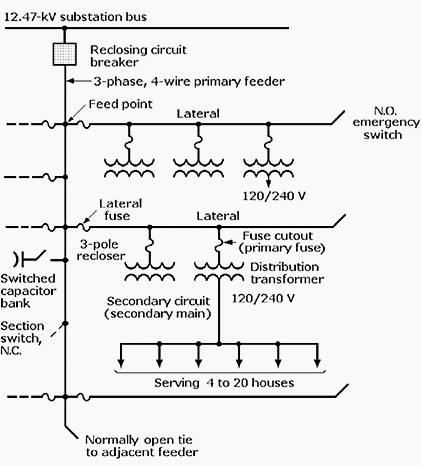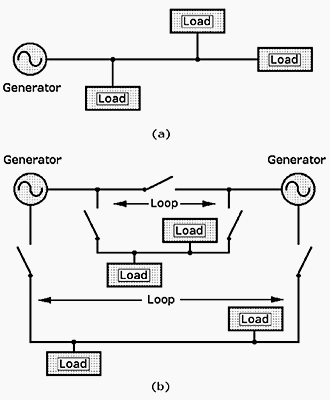Primary (distribution) feeders
The primary distribution system is that part of the electric distribution system between the distribution substation and distribution transformers. It is made up of circuits called primary feeders or distribution feeders.

These feeders include the primary feeder main or main feeder, usually a three-phase, four-wire circuit, and branches or laterals, which can be either three-phase or single-phase circuits.
These are tapped from the primary feeder main, as shown in the simplified distribution feeder diagram of Figure 1. A typical power distribution feeder provides power for both primary and secondary circuits.

In primary system circuits, three-phase, four-wire, multigrounded common-neutral systems, such as 12.47Y/7.2 kV, 24.9Y/14.4 kV, and 34.5Y/19.92 kV, are used almost exclusively. The fourth wire of these Y-connected systems is the neutral, grounded at many locations for both primary and secondary circuits.
Three-phase loads can be supplied by three-phase distribution transformers or by single-phase transformers connected to form a three-phase bank. Primary systems typically operate in the 15kV range, but higher voltages are gaining acceptance.
The primary feeder main is usually sectionalized by reclosing devices positioned at various locations along the feeder. This arrangement minimizes the extent of primary circuitry that is taken out of service if a fault occurs. Thus the reclosing of these devices confines the outage to the smallest number of customers possible. This can be achieved by coordinating all the fuses and reclosers on the primary feeder main.
In above block diagram Figure 1, distribution substation voltage is 12.47 kV line-to-line and 7.2 kV line-to-neutral (this is conventionally written as 12,470Y/7200 V). However, the trend is toward higher primary four-wire distribution voltages in the 25kV to 35kV range. Single-phase feeders such as those serving residential areas are connected line-to-neutral on the four-wire systems.
The use of underground primary feeders that are radial three-conductor cables is increasing. They are serving urban areas where load demand is heavy, particularly during the hot summer months, and newer suburban residential developments. Both cost factors and the importance of reliability to the customers being served influence the design of primary systems.
Radial and Loop Distribution Systems //
Comparison
The simplest and least expensive (as well as least reliable) configuration is the radial distribution system shown in Figure 2a, because it depends on a single power source.

As a hedge against outages, most utilities plan their distribution systems so that they will have backup if those events occur. The goal of all electrical distribution systems is the economic and safe delivery of adequate electric power to serve the electrical loads.
The reliability of the primary feeder can be improved with the installation of a loop distribution system, as shown in Figure 2b.
In loop systems the feeder, which originates at one bulk power source, “loops” through the service area and several substations before terminating at the original substation or another bulk source. The strategic placement of switches at the substations permits the electric utility to supply customers in either direction.
If one power source fails, switches are opened or closed to bring an alternative power source online.
Loop systems provide better service continuity than radial systems, with only short service interruptions during switching. However, they are more expensive than radial systems because of the additional switching equipment requirements. As a result, loop systems are usually built to serve commercial and light industrial buildings and shopping malls, where power outages are more likely to endanger human lives or result in property losses.
Reliability and service quality can be significantly improved at even higher cost with a multiple parallel circuit pattern. In these systems, two or more circuits are tapped at each substation. The circuits can be radial or they can terminate in a second bulk power source. These interconnections permit each circuit to be supplied by many different substations.
Reference: Handbook of electrical design details // Second edition – Neil Sclater; John E. Traister (Purchase ebook)











hello mr Edvard, ..thank you for your lecture
i need to ask you one question to make it clear
what are the main points considering to upgrade 15 kv radial primary distribution system to 15 kv loop primary distribution system?
thank you for your respond
It depends on your exact needs and existing infrastructure. Generally loop systems provide better service continuity, and this is important. They have short voltage interruptions during switching.
It’s like comparing cars for example Kia and BMW. They both drive good, but the quality of driving is not the same.
Edvard: is there any practical or recommended limit with regards to the number of transformers to be connected in a loop feed circuit ? I work in recommending transformer manufacturers the size of components (we provide) for their transformers. Since one of the transformer’s bushings might carry the current of the rest of transformers downstream, I wonder if a limit is given for the number of transformers in a loop circuit. Typical maximum rated current for the HV bushings we provide for loop applications is 600 to 900 amperes.
Hi Edvard,
I hope you are doing very well.
I take interest in your articles and gaining knowledge from you.
I would appreciate you, if you could provide me a link, or website or anything that helps me to design a new 33/11 kv substation. I have to provide a presentation on it very soon.
Thank you very much for your consideration.
Bishwa
could you please provide more detail on medium voltage with neutral systems? as far as i know there is not even neutral conductor inside the Mv switch-gears with 3 phase 3 wires . thnx
i learn a lot about primary distribution system in such a simplified way thank you
i learn a lot about primary distribution system in very easy way . especially that simplified diagram of loop distribution system which shows how two or more alternator can be connected to provide power to more loads thank you.